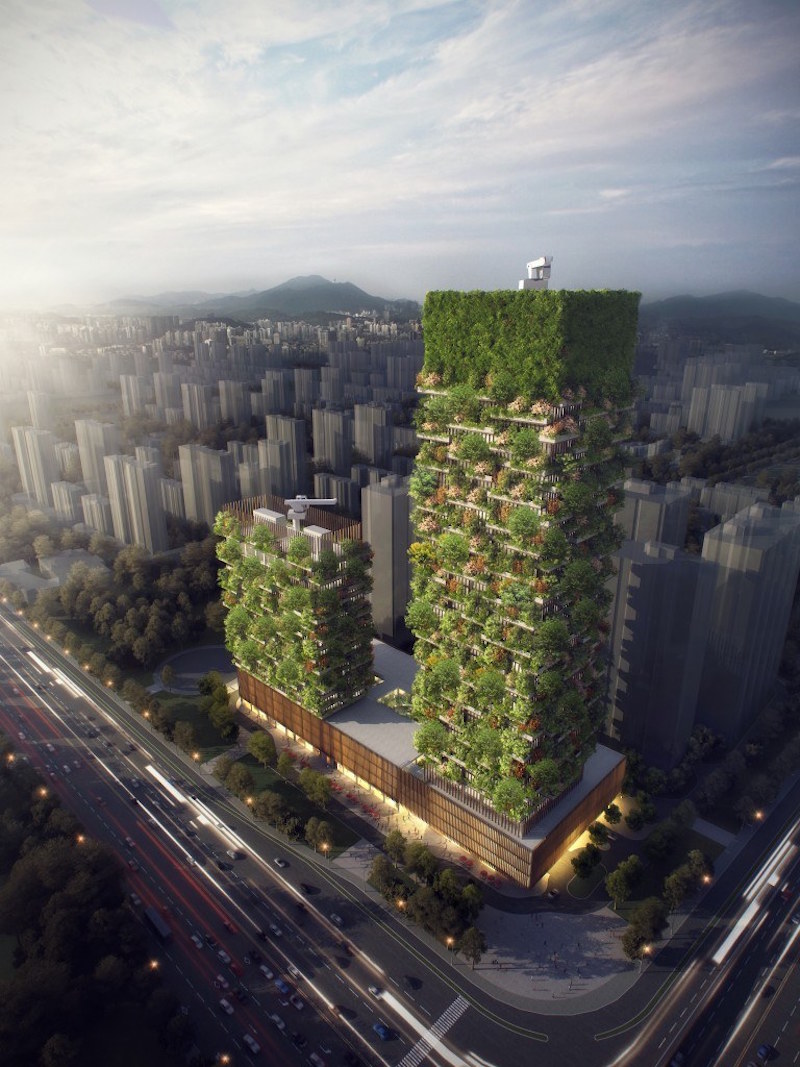A new mixed-use project from Stefano Boeri Architects, Nanjing Vertical Forest will comprise two towers rising from a 20-meter shared podium. What makes this project unique is, according to the architects, this will be the first vertical forest built not only in China, but in all of Asia.
The building’s facades will feature 600 tall trees and 500 medium trees from 23 different local species. Another 2,500 cascading plants and shrubs will be included, as well. In total, the trees and other plants will cover a 6 square mile area and absorb 25 tons of CO2 per year. The plants will also produce about 60 kilograms of oxygen per day. To help put that into perspective, the average person needs 0.84 kilograms of oxygen per day, according to NASA.
One of the towers will rise 200 meters and be topped with a “green lantern” while the other tower will rise 108 meters. The 200-meter tower will include a museum, a green architecture school, and a private rooftop club. The 108-meter tower will house a 247-room Hyatt hotel and a rooftop swimming pool. Both towers will rise from a 20-meter podium that will host retail space, a food market, restaurants, a conference hall, and exhibition spaces.
The project is Stefano Boeri Architects’ third vertical forest prototype, after Milan and Lausanne. The firm plans to bring vertical forests to other Chinese cities such as Guizhou, Shanghai, and Chongqing at a later date. The Nanjing Vertical Forest will be completed in 2018.
 Rendering courtesy of Stefano Boeri Architects.
Rendering courtesy of Stefano Boeri Architects.
 Rendering courtesy of Stefano Boeri Architects.
Rendering courtesy of Stefano Boeri Architects.
Related Stories
HVAC | May 28, 2024
Department of Energy unveils resources for deploying heat pumps in commercial buildings
To accelerate adoption of heat pump technology in commercial buildings, the U.S. Department of Energy is offering resources and guidance for stakeholders. DOE aims to help commercial building owners and operators reduce greenhouse gas emissions and operating costs by increasing the adoption of existing and emerging heat pump technologies.
Resiliency | May 24, 2024
As temperatures underground rise, so do risks to commercial buildings
Heat created by underground structures is increasing the risk of damage to buildings, recent studies have found. Basements, train tunnels, sewers, and other underground systems are making the ground around them warmer, which causes soil, sand, clay and silt to shift, settle, contract, and expand.
Senior Living Design | May 16, 2024
Healthy senior living campus ‘redefines the experience of aging’
MBH Architects, in collaboration with Eden Housing and Van Meter Williams Pollack LLP, announces the completion of Vivalon’s Healthy Aging Campus, a forward-looking project designed to redefine the experience of aging in Marin County.
Sustainability | May 10, 2024
Perkins&Will’s first ESG report discloses operational performance data across key metrics
Perkins&Will recently released its first ESG report that discloses the firm’s operational performance data across key metrics and assesses its strengths and opportunities.
Sustainable Development | May 10, 2024
Nature as the city: Why it’s time for a new framework to guide development
NBBJ leaders Jonathan Ward and Margaret Montgomery explore five inspirational ideas they are actively integrating into projects to ensure more healthy, natural cities.
K-12 Schools | May 7, 2024
World's first K-12 school to achieve both LEED for Schools Platinum and WELL Platinum
A new K-12 school in Washington, D.C., is the first school in the world to achieve both LEED for Schools Platinum and WELL Platinum, according to its architect, Perkins Eastman. The John Lewis Elementary School is also the first school in the District of Columbia designed to achieve net-zero energy (NZE).
K-12 Schools | Apr 30, 2024
Fully electric Oregon elementary school aims for resilience with microgrid design
The River Grove Elementary School in Oregon was designed for net-zero carbon and resiliency to seismic events, storms, and wildfire. The roughly 82,000-sf school in a Portland suburb will feature a microgrid—a small-scale power grid that operates independently from the area’s electric grid.
75 Top Building Products | Apr 22, 2024
Enter today! BD+C's 75 Top Building Products for 2024
BD+C editors are now accepting submissions for the annual 75 Top Building Products awards. The winners will be featured in the November/December 2024 issue of Building Design+Construction.
Codes and Standards | Apr 12, 2024
ICC eliminates building electrification provisions from 2024 update
The International Code Council stripped out provisions from the 2024 update to the International Energy Conservation Code (IECC) that would have included beefed up circuitry for hooking up electric appliances and car chargers.
Codes and Standards | Apr 8, 2024
First federal blueprint to decarbonize U.S. buildings sector released
The Biden Administration recently released “Decarbonizing the U.S. Economy by 2050: A National Blueprint for the Buildings Sector,” a comprehensive plan to reduce greenhouse-gas (GHG) emissions from buildings by 65% by 2035 and 90% by 2050.

















